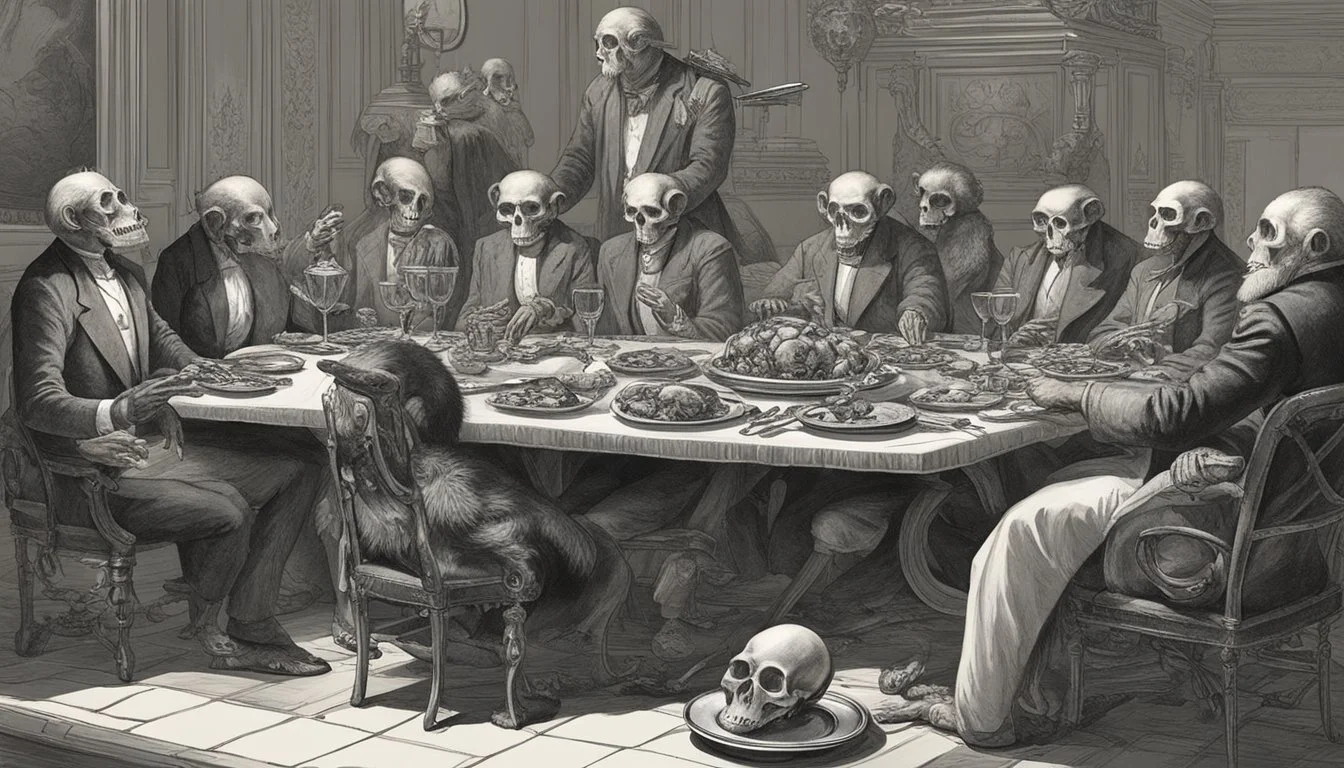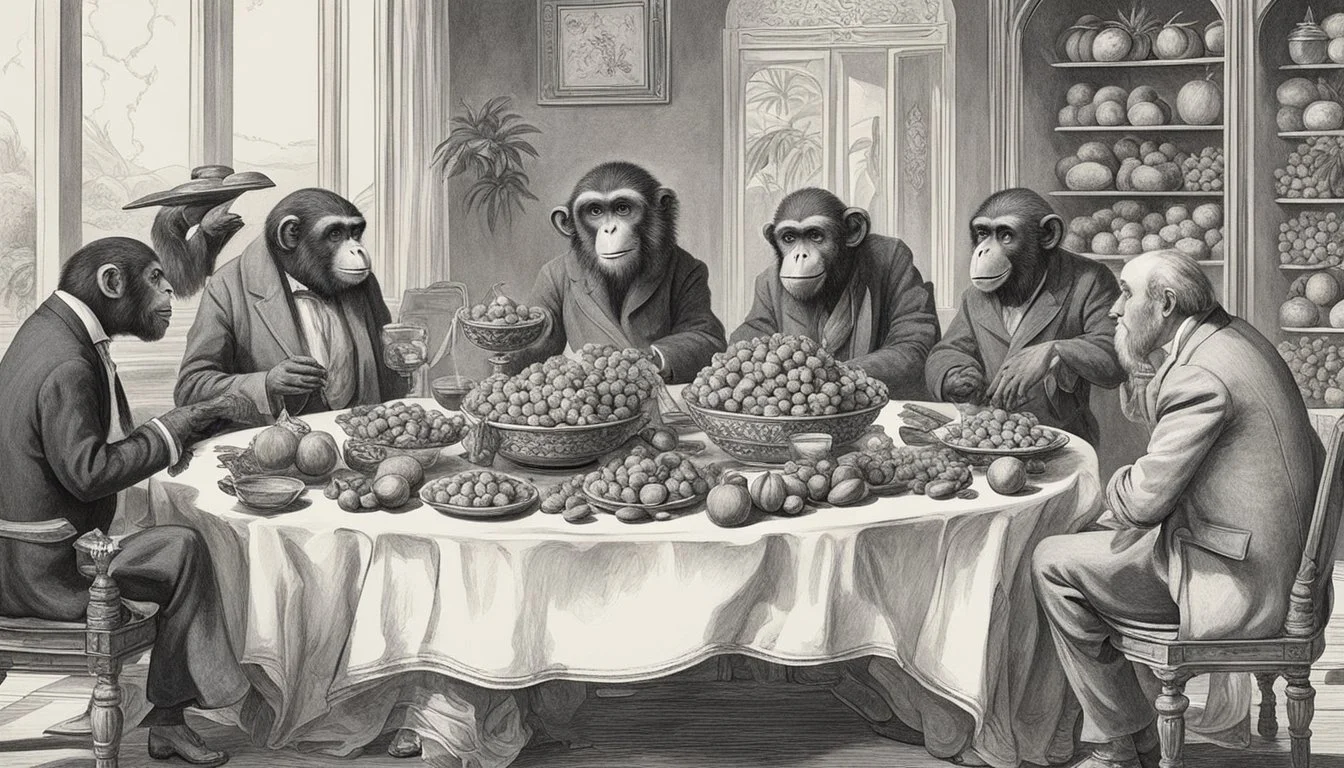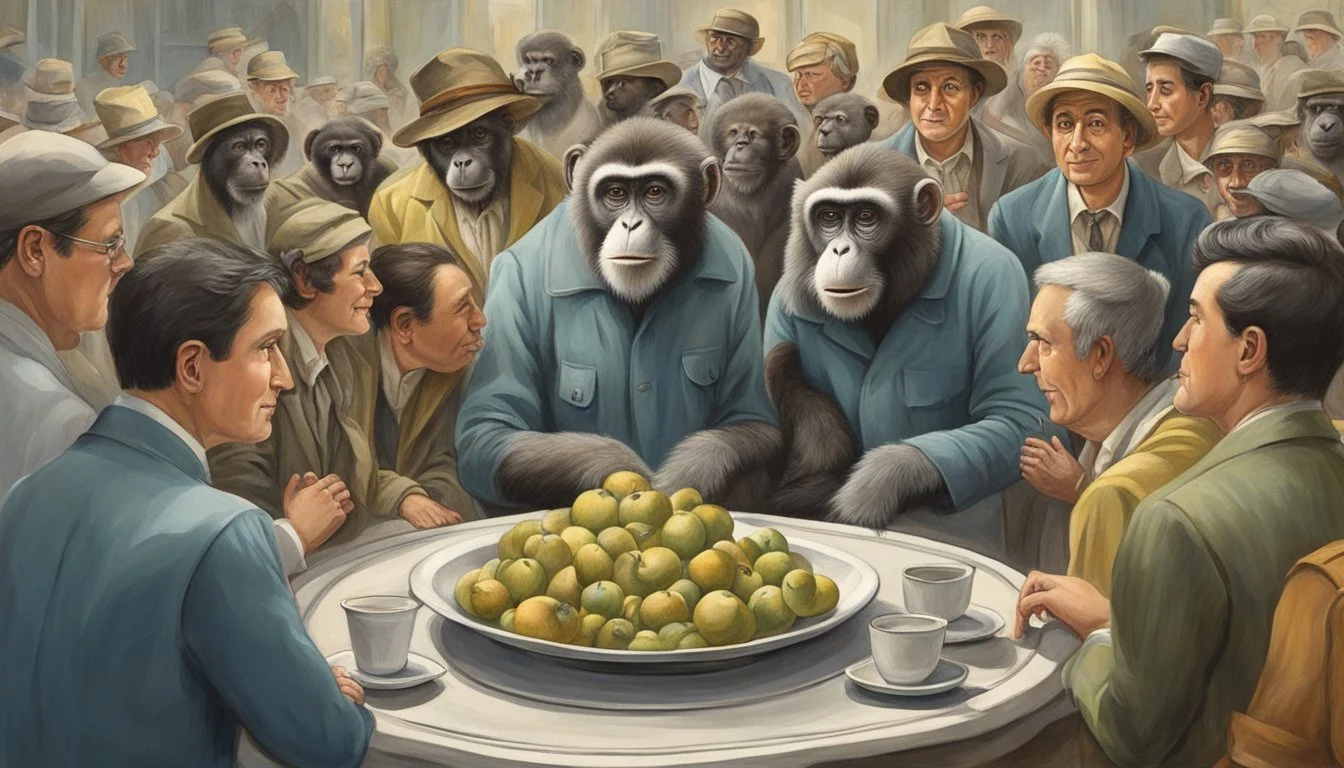Monkey Brains
Unpacking the Controversial Culinary Practice
The consumption of monkey brains has long been shrouded in controversy and intrigue. Often regarded as a taboo delicacy, the act of eating the brain matter of monkeys is a topic that elicits strong emotional reactions ranging from disgust to curiosity. While the practice is linked to various cultures, and there's significant debate over its authenticity and extent, it remains a point of interest and sometimes a conversation starter in discussions about exotic foods and cultural practices.
In particular, the idea of monkey brains as food has been sensationalized in Western media, occasionally being portrayed in films and literature, which has contributed to the allure and mystery surrounding the subject. It's a subject mired in ethical concerns, health implications, and legal aspects, as many species of monkeys are protected, and the consumption of their brains raises significant conservation and welfare issues.
Historically, brain consumption, in general, has been present in various cuisines, but the specific consumption of monkey brains is surrounded by rumors and often lacks concrete evidence. Despite this, the mere suggestion of monkey brains as a delicacy continues to provoke discussion, serving as a cultural touchpoint for broader issues of culinary differences, ethical eating choices, and the boundaries of gastronomic ventures.
Exploring the Origins of Monkey Brain Consumption
Monkey brain consumption has been steeped in controversy, often associated with exoticism and ethical concerns. Its history varies by region and is largely shaped by cultural significance and dramatized media portrayals.
Historical Significance in Various Cultures
In some cultures, specifically within parts of Asia, the consumption of animal brains includes those of monkeys. It's debated whether monkey brains have ever been widely consumed as a delicacy. The practice is often attributed to China, where various traditional dishes use unusual ingredients, although the actual prevalence of monkey brains in the diet has been questioned.
China: Mentioned in historical texts and rumored within regional stories, but concrete evidence of widespread consumption is lacking.
Cultural Significance: In the contexts where it is acknowledged, the consumption of monkey brains is sometimes seen as a means to gain the animal's strength or intelligence, although such beliefs are not universally held or practiced.
Despite the rarity of this practice, the perceived historical significance has had lingering effects on the perception of certain cultures.
The Influence of Media on Perception
Media portrayals have significantly shaped the global view of monkey brain consumption. The 1984 film Indiana Jones and the Temple of Doom featured a scene where characters are served monkey brains, which led to widespread fascination and revulsion. Such dramatic representations, often without basis in common culinary practices, have left lasting impressions that may not align with reality.
United Kingdom and Western Culture: The film's depiction has notably influenced Western perspectives, leading to misconceptions regarding the prevalence of the dish in Eastern cultures.
Media Impact: Continual references in films, television, and literature have perpetuated the trope, impacting perceptions more than factual accounts of this practice.
Through the combination of occasional historical practices and fictional media representations, the topic of monkey brain consumption remains a conversational piece, often detached from the realities of culinary traditions and current practices.
Culinary Practices and Preparation Techniques
The preparation of monkey brains as a dish involves a variety of techniques that have evolved from traditional methods to modern culinary interpretations. Chefs focus on refining recipes to enhance flavor and taste while paying attention to prep and cook times.
Traditional Recipes and Cooking Methods
Traditional recipes for monkey brains include a range of cooking methods such as grilling, sautéing, and steaming. Historical records suggest that in some cultures, the brain was consumed raw, but more often it was cooked to create a different texture and flavor profile.
Ingredients: Along with the brain, chefs might incorporate common flavor enhancers like garlic or local spices.
Prep Time/Cook Time: Preparation and cooking times varied based on the recipe. Steaming, for instance, tends to be a quicker method than others.
Taste: The resulting taste is influenced greatly by the chosen spices and cooking techniques.
Modern Interpretations and Fusion Dishes
Modern chefs have approached monkey brains with a fusion mindset, bringing in elements from other culinary traditions to reimagine this controversial dish.
Recipe Innovation: New recipes often integrate ingredients not traditionally associated with the dish, experimenting with flavors to appeal to a wider demographic.
Flavor: These reinterpretations aim to balance the innate flavors of the brain with complementary tastes from various cuisines.
Total Time: Contemporary recipes may focus on reducing the total time to make the dish more accessible in a fast-paced culinary world.
Health and Nutritional Information
This section provides a factual overview of the nutritional aspects of monkey brains and the potential implications for health when consumed by humans.
Nutrient Content of Monkey Brains
Monkey brains, an exotic food claimed to be consumed in certain cultures, though often considered an urban legend, are said to contain a significant amount of protein, which is vital for muscle repair and enzyme function. As an organ meat, brains are also dense in various nutrients such as omega-3 fatty acids, selenium, and cholesterol. However, the specific nutrient content can vary widely depending on the species and the diet of the monkey.
Protein: High in complete proteins that contain all essential amino acids.
Cholesterol: Significantly high levels, which could impact cardiovascular health.
Nutrients: Rich in omega-3 fatty acids, selenium, and other micronutrients beneficial for brain health.
Potential Health Risks and Safety Concerns
Consuming monkey brains, aside from being a controversial and ethically charged practice, also carries potential health risks. The chief concern involves the transmission of diseases from primates to humans. For example, a condition similar to Mad Cow Disease, known as variant Creutzfeldt-Jakob disease, is linked to the consumption of infected neural tissue and is a critical safety concern.
Diseases: Potential for zoonotic disease transmission, including prion diseases.
Diet and Health: The high cholesterol content could pose a risk to individuals with dietary restrictions or pre-existing health conditions.
The consumption of monkey brains is not only taboo but also poses substantial health risks that should be seriously considered.
Ethical Considerations and Controversies
The consumption of monkey brains has long been mired in ethical debates and cultural disputes. It touches upon the treatment of animals, legal frameworks, and often clashes with various cultural beliefs and scientific facts.
Animal Rights and Legal Status
Ethics and Animal Welfare: The practice of consuming animal brains, specifically those of monkeys, raises significant ethical questions regarding the treatment of animals. It concerns their right to life and the morality underpinning the infliction of death for the sake of a delicacy.
Legal Considerations: In many countries, stringent laws protect primates, categorizing them as endangered species. The legality of consuming monkey brains thus becomes a matter of both international wildlife conservation law and domestic legal enforcement.
Cultural Sensitivities and Misconceptions
Cultural Misunderstandings: Misconceptions often arise around the consumption of monkey brains, with exaggerations of its prevalence leading to undue stigmatization of certain cultures. The reality is that it's a rare practice, limited to certain regions and often condemned.
Respecting Beliefs: Addressing the topic demands sensitivity to cultural practices while also promoting informed discussion on the ethical implications. The respect for cultural diversity must be balanced against the global efforts to protect animals and oppose cruelty.
Global Perspectives and Regulations
The consumption of monkey brains is a subject of legal scrutiny and cultural controversy across the globe. Laws vary significantly, with some countries implementing strict regulations against the practice, while cultural perceptions also influence the acceptance of such dishes.
Consumption Laws in Different Countries
Hong Kong: Strict laws exist to protect wildlife, making it illegal to sell, possess, or consume monkey brains. These laws also support conservation efforts and align with international wildlife protection treaties.
Beijing, and by extension Mainland China, has regulations in place that prohibit the hunting and trading of various wildlife species, which would include monkeys for consumption. However, enforcement and adherence to these laws can vary.
Hong Kong: Illegal
Beijing/Mainland China: Typically Illegal, varies with enforcement
Cultural Acceptance and Taboos
Chinese Food: (What wine goes well with Chinese food?) In certain regions, exotic dishes are historically part of the cuisine, but this does not imply widespread acceptance. Monkey brain consumption, often surrounded by myths, is largely condemned in modern society and seen as a taboo practice against animal welfare.
Chinese Medicine: No significant links between monkey brains and traditional Chinese medicine have been documented. The practice is not supported by mainstream medicine and is often discouraged due to ethical and health concerns.
Cultural perceptions surrounding monkey brain consumption are mixed, with the practice facing substantial opposition due to ethical, health, and environmental considerations.
The Sensory Experience of Eating Monkey Brains
Eating monkey brains presents a unique sensory experience, defined by its distinctive texture and complex flavor profile that compares with other rare delicacies.
Describing the Texture and Flavor Profile
Monkey brains, when consumed, can offer a texture that is simultaneously tender and creamy, often resembling the softness of certain organ meats like foie gras. Flavor-wise, they carry a subtle richness similar to a milder version of liver, without the iron-heavy aftertaste of blood. Regular diners of organ meats may find the taste familiar, while those new to such textures might compare it to a very soft pâté.
Comparisons with Other Delicacies
Monkey brains are sometimes compared to other traditional delicacies:
Duck (What wine goes well with duck?) Foie Gras: Both have a creamy, melt-in-the-mouth texture, but monkey brains are generally smoother.
Liver: The richness of monkey brains is comparably less intense than that of liver, which has a stronger and more acquired flavor.
Heart: Unlike heart, which has a firm texture, monkey brains are far more delicate on the palate.
Serving and Presentation
In the world of exotic and taboo delicacies, the presentation of monkey brains plays a pivotal role in both traditional customs and modern dining experiences, often reflecting the cultural backdrop and the inherent luxury associated with the dish.
Traditional Serving Methods
Traditionally, monkey brains have been served in a manner befitting their status as a dish for the affluent or for special occasions. In some cultures, the brain is presented in the skull of the monkey, reflecting a ritualistic and controversial practice that is often tied to long-standing beliefs and customs. This has typically been associated with high-status individuals or special events within the family or community. Restaurants that feature such traditional delicacies may adopt similar presentation practices to offer a more "authentic" experience.
Contemporary Plating Styles
Modern food writers and chefs, seeking to reinterpret this controversial food item, employ innovative plating styles that respect ethical considerations and focus on the culinary aspects. Restaurants aiming to feature this dish may use:
Individual ramekins or small bowls
Edible garnishes such as flowers or microgreens
Flavorful drizzles or sauces
These contemporary styles aim not only to create an aesthetically pleasing dish but also to distance the modern preparation from the less palatable aspects of traditional practices, making it more accessible to a wider, potentially international audience. The shift in plating reflects a consciousness of modern sensibilities and an evolving palate among adventurous diners.
Cultural Impact and Conversations
Monkey brains as a topic has rippled through popular culture and social discussions, often seen as a taboo delicacy. This section delves into its portrayal in media and its role in dining conversations.
Monkey Brains in Popular Culture
Indiana Jones and the Temple of Doom has played a significant role in embedding the idea of monkey brains as a food item in Western consciousness. The 1984 film showcased a scene where the brains were eaten, cementing its exotic and often misrepresented status in popular culture. Although the consumption of animal brains is not uncommon in various cuisines, the specific act of eating monkey brains has been scrutinized and is usually met with a mix of intrigue and unease, further fueling conversations and myths.
Dining as a Social Experience
Discussions about unusual foods, including monkey brains, serve as a potent conversational catalyst in social dining experiences. Such taboo subjects tend to spark interest and debate over the limits of cultural practices and the ethics around exotic cuisine. Dining is not only about sustenance but also about the stories and conversations shared around the table, which issues like these often provide. When people gather and converse over unique dishes, it can sometimes encourage a deeper understanding of different cultural norms and practices, leading to a broader perspective of what defines "appropriate" cuisine.
Alternative Ingredients and Substitutes
When exploring culinary alternatives to monkey brains, one must consider both ethical implications and taste profiles. Vegetarian, vegan, and similar-tasting dishes provide ways to enjoy unique flavors without the controversy.
Vegetarian and Vegan Options
Vegetarians and vegans can replicate the creamy texture associated with animal brains by using plant-based foods. For example, avocado or tofu can serve as rich, smooth bases. Tofu in particular, when prepared with skill, can mimic the soft consistency of brains. Culinary creativity can also turn cake or Jell-o into whimsical, brain-like molds that are not only visually appealing but also offer a completely animal-free way to engage with this taboo delicacy.
Avocado: A fatty, creamy texture that can be scooped or molded.
Tofu: Soft silken tofu offers a consistency similar to cooked brain.
Similar Tasting Dishes Without Using Monkey Brains
To achieve a similar taste profile without consuming monkey brains, one might consider dishes involving other animal brains like lamb. However, for ethical reasons or dietary restrictions, alternatives like preparing duck heads with expertly blended herbs and spices can deliver a depth of flavor. Custard is another alternative, where the silky texture and richness may satisfy the sensory elements linked to eating brains without the associated ethical concerns.
Lamb brains: Can be gently fried and seasoned to taste.
Duck heads: Spice-infused and stir-fried, characterized by a crispy texture.
Custard: A dessert offering smoothness and flavor depth, echoing aspects of brain's texture.
Conclusion
The practice of eating monkey brains has long been shrouded in mystery and controversy. While the consumption of animal brains is not uncommon in various cuisines, monkey brains have been the subject of debate, with discussions often touching on ethical concerns, food safety, and cultural sensitivity.
In certain cultures, eating monkey brains is believed to grant health benefits, such as improved intelligence or strength. However, these beliefs are not supported by scientific evidence and are likely more myth than reality. Moreover, health risks also exist, stemming from diseases that can be transmitted from primates to humans.
As societies become more interconnected, there is an increasing awareness and understanding of the importance of responsible consumption. It is imperative that traditional practices involving food are also scrutinized under contemporary ethical standards. This includes respecting animal welfare and considering the sustainability and ecological impact of dietary choices.
In closing, the subject of monkey brains as a food item remains a potent topic for discussion, one that often elicits strong emotional responses. It serves as a platform for a wider conversation about the intersection of tradition, cultural understanding, and evolving ethical perspectives on food and consumption.












